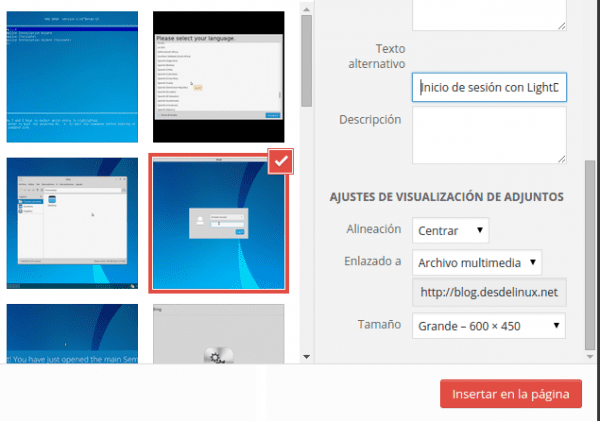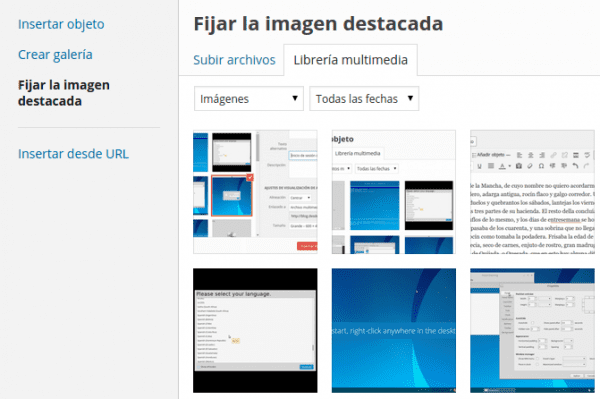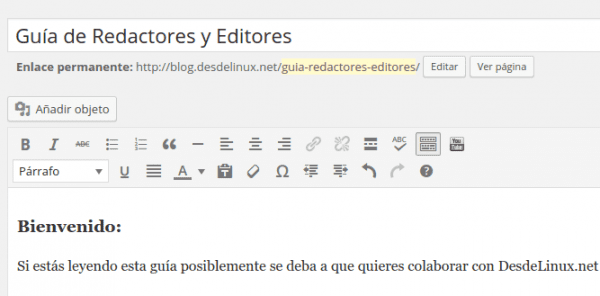Welcome:
If you are reading this guide, it may be because you want to collaborate with DesdeLinux.net and that fills us with pleasure.
As you know, DesdeLinux.net is a blog that has been gaining many followers for the quality of its articles and the community spirit that is breathed around it.
We believe in The Community and in how valuable your contributions can be, and that is why anyone who wants and is interested can transmit their knowledge and experiences through our blog. We do not charge or pay for it! It is only necessary to have the desire to share.
This guide aims to show what are the elements to take into account when publishing an article. Complying with the parameters outlined below not only makes articles better quality, but saves a lot of work for the editing team.
If for any reason you do not follow the requirements set out in this document step by step, it is possible that your article will be delayed in being approved or simply not published. Help us spread free knowledge.
If you have any questions, please send them to our email staff@desdelinux.net with the subject: Editorial Guide.
Thank you for wanting to collaborate !!!
Editors Team
DesdeLinux.net
Requirements to write a good article
There are some fundamental requirements that must be taken into account when publishing an article on DesdeLinux. The main thing is that you want to share, but you must reach readers in the simplest, cleanest and most correct way possible. Let's look at some of the details that we must take into account:
Working with the text
If possible, do not Copy / Paste
En DesdeLinux We have always been known for offering original content, and even if the article is copied from another site, we always try to capture the idea and with our words or from our point of view, we create a new article.
The main thing is to avoid copyright problems, in addition to avoiding penalties from Google for duplicate content. In this way we can take care of the quality level of the blog.
Pay close attention to spelling
One of the most difficult tasks when reviewing the article before publishing it is correcting misspellings, accents, commas, and other punctuation marks, as well as correcting the misuse of upper and lower case.
At the beginning of the sentence and in proper names such as Facebook y Skype or Whatsapp It begins with an initial capital letter. The name of applications like Pidgin, Amarok, etc. They are proper names and therefore also have a capital initial letter.
Never forget to place the source from which the information is being taken
In the event that the article you want to write comes from another website, you must put a link DIRECT to the source. In the event that said source does not have a digital version, the name, title, number, edition, etc. are still clear. This is mostly for an ethical issue.
Contenido obligatorio
The three elements that should not be missing in an article are:
Outstanding image: It should be an image preferably according to the topic of the article. It should be a striking image, and with proportion 4:3, that is, that it is more wide than high. Normally WordPress takes care of cutting and adjusting the image. (How to insert a featured image is explained below)
Categories: Verify that the article is in the appropriate Category, which should only be one a unless you consider that it should also be an article Recommended.
Tags: Tags are simple or compound words that mention important parts of the article. For example, if the article is about an application called Gedit and its operation in Ubuntu, the labels can be gedit, ubuntu (always separated by commas). If the article is a cheat, howto, or something similar, then the tags could be gedit, ubuntu, tips, how-to.
Search before posting
Before you start writing an article, you should search for it on the blog to verify that it has not been previously published.
It is important that before publishing an article use the site's search engine to see if something has already been published on the subject. In this way we not only avoid duplicating content, but we can cite previous articles to feed the content the story we want to tell.
Work with images
It is important to highlight that All the images that we are going to use for our article must be uploaded to the blog and not use external resources or links. In this way we guarantee that they will always be available.
Insert images
To insert an image we just have to click on the button: Add object:
This will give us two options: Upload files o choose an existing image from the Media Library.
When putting images in the article, we must take into account 3 parameters that are mandatory:
- That the image has an Alternative Text
- That comes out aligned to the Center
- That has a large size
as seen below:
We must always select an image as featured. If you can't find an image for the post, you can search for it in the Multimedia Library with the available images.
Work with ShortCodes
Use shortcodes: Maybe this part can be a bit complicated, but it is not difficult. Our blog supports certain indicators that provide a better format for articles. Shortcodes are enclosed in brackets, and there is always an opening and a closing one. Let's see some examples, notice that we add a space inside the brackets so that the syntax can be appreciated:
[info] text to display [/ info]: This indicator is used to provide supplementary information or to note something relevant that is not dangerous. For example: [info] It is used to offer additional information to the article [/ info]
[alert] text to display [/ alert]: This indicator is used to highlight some information that is of priority, such as possible errors and others. For example: [alert] It is used to prohibit something that is dangerous to do in the article ... [/ alert]
[warn] text to display [/ warn]: This indicator is used to alert the user to anything, in order to be careful, but that it is not dangerous to do so. For example: [warn] It is used to alert about anything in the article [/ warn]
[winner] text to display [/ winner]: If we want to recognize someone or something, this is the indicator that is used for it. For example: [winner] This is a text to recognize someone or something in the post [/ winner]
I work with SEO
SEO is nothing more than the positioning that we can obtain in Google and other search engines, but mainly in Google, that simple. But for Google to give us a good place, we must take several things into account when writing our article.
For an article to be relevant to Google Robot, must be no less than 300 words. We understand that long articles cannot always be written, but always keep this in mind.
Highlighting bold words and emphasis in italics
When we write an article, it is always good to highlight what we are talking about or things related to it. For example, if we talk about Kubuntu, words like: KDE, Ubuntu, etc. Words in Bold are detected by search robots and get priority in the results. We can also emphasize a phrase, word or fragment by placing the text in italics.
Categories
Generally, an article can have many Tags (labels), but no more than 2 categories. For example, if we talk about Unity y Ubuntu, only Category should be used: Desktop Environments. They will only be marked as Recommended Products, those articles that contain valuable information such as Tips, HowTo or some major relevance.
Use of Tags
Tags are very useful when looking for content on the blog, if we use the url for example https://blog.desdelinux.net/tag/.
Tags that have spaces, such as linux like, are converted to linux mint, so to search for articles related to this tag we use the url: https://blog.desdelinux.net/tag/linux-mint. Multiple tags can be used in a post, but it is advisable not to extend to more than 6.
ALT property in images
As we explained above, the images must have a Alternative Text, if possible, that is related to the title or subject of the post. The Alternative Text is not only indexed in search engines, but also offers information about the image if for some reason it could not be displayed. If we are talking about Ubuntu, the image should have in its Alternative Text the word Ubuntu. It doesn't matter if it's before or after, or if it's a prayer.
Division of content into sections
Dividing the content of articles into sections is a recommended practice as it makes them easier to read and, if done correctly, can improve SEO. To do this, you must use the headers to format the section title. For example:
Title of a section of my article
text…
Title of another section
text…
They can also be used and for the subsections of a section.
Why not use a or
Simple, because every HTML document to be well indexed by Google must only have a single which will almost always be in the website logo. In the order of hierarchy, he is followed by , what in DesdeLinux is used for the title of the article, so the sections must be with onwards.
Permanent Links
If you notice, whenever we put the title of an article, WordPress puts the URL of the article at the top of the text editor:
If the title of our article is, for example: Editors and Editors Guide, WordPress will put us as a permanent link: editors-and-editors-guide. This permanent link is not bad at all, it is quite short, but a good practice is to leave only the words keys that we want Google to show us in a search result.
The permanent link can be edited with the button right next to it and in this example, it would be advisable to leave it as shown in the image above: guide-writers-editors.




